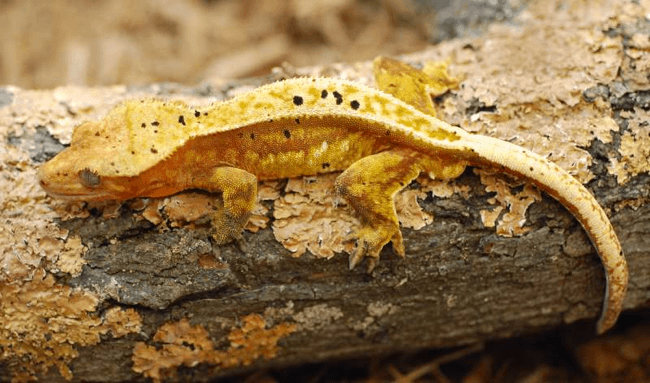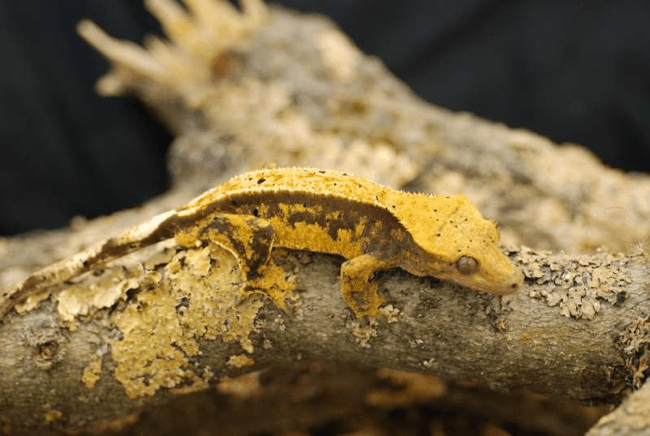Rediscovered nearly 20 years ago, renamed about a year ago (genus designation changed from Rhacodactylus to the original 1866 designation of Correlophus), the Crested Gecko has surged in popularity in all its various colors –though most of them look kinda brown to me. One theme that runs throughout the accounts of the three gecko experts below is the attractive look and feel of these wonderful creatures. Enjoy!
As usual, each expert has responded to the following 5 questions:
1. Which morphs are you keeping?
2. What got you interested in this species and where did you get your first one?
3. How are they set up? Describe your enclosure
4. What do you find most interesting about them?
5. What do you find to be the biggest challenge?
Garrick DeMeyer
I have a variety of crested gecko morphs including flame, harlequin, pinstripe, dalmation, tiger, and combinations of all of those.
I bought my first crested geckos back in 1998 when they were still fairly rare in the US. The came from Kevin Dunn. At the time, I was looking for a new species to add to my collection- one that would really take the reptile world by storm. As soon as I opened the box and saw those first juvenile cresteds, I knew I found what I was looking for. I immediately started buying up small groups of babies and the very few adults I could find to get my breeding colony set up. Within a few years, I was one of the biggest producers of crested geckos in the US.
I’ve housed my colonies in several cage types over the last 15 years. I’ve used large, tall plastic tubs with screen tops, rack systems, and various cages. Currently, I am using Vision Cages that measure 28x24x24 inches. I use cypress mulch for a substrate, several tubes or cork bark, thin branches, and artificial plants for climbing and hiding places. I have a nest box filled with eco earth. I keep them in a temperature-controlled room so I don’t use heat on their cages. I do have an 18″ fluorescent strip light over each cage.
I think there are a lot of things are that interesting about crested geckos. Just look at them! They have such a cool body design and the array of colors and patterns that they show is impressive. Even before selective breeding really got started with them, there were so many colors and patterns. When I go to reptile expos now, I spend a lot of time looking at other breeders’ geckos and I’m just amazed at how far they’ve come.
I’ve faced a few challenges with crested geckos over the years. When I first started breeding them, I was having a fair amount of babies die in the egg when they were hatching. That was frustrating, but doesn’t really happen to me often anymore. The other challenge I’ve had is geckos not breeding for long periods of time. Back in the early ’00s, I started using a lot more babyfood with my geckos and got away from crickets. My geckos stopped breeding for almost a year. I started feeding more crickets again and started using the newly introduced Repashy Superfoods Crested Gecko Diet and the problem was solved. More recently, I moved my crested geckos from one room in my facility to another and they stopped breeding again. I believe the room I moved them into was just too hot for them. I have since moved them again to a room with a more suitable temperate.

Sharell Lagunas
I specialize in Extreme Harlequin, Harlequin, and Pinstripe in reds and dark base with high contrast.
I was first introduced to crested geckos (Correlophus ciliatus, formerly Rhacodactylus ciliatus) while attending a local reptile expo in Salt Lake City, UT. There I met Melanie Bertolio (Bertopia Geckos) who had a booth with stunning crested geckos. She introduced me to the species, told me about their care, and I left with “The Bug”. Melanie has since become a close friend. I researched them for another year before getting my first pair from a local breeder who was getting out of the hobby. In a very short time my colony grew from those original two to a humble breeding group.
I prefer to house my geckos in plastic bins as they are light-weight, easy to clean, and inexpensive. My adults are housed in a 26″x18″x18″ vertically oriented bin, juvies are in a 14″x11″x11″ bin, and hatchlings are in a 12″x8″x6″ bin. I use paper towel as a substrate. It is economical, easily changed, offers little risk of impaction, and I can easily monitor feces for health reasons. I provide many climbing areas as these are an arboreal species along with ample foliage for security. I also include a laybox or moist hide in every enclosure from hatchling to adult. I find many geckos enjoy digging and rooting in them even if they aren’t laying eggs and a humid retreat is always a good fallback if relative humidity drops too low. I also provide a hiding spot low to the ground or on the ground for geckos that prefer to sleep lower in the enclosure. A rough, but not sharp rock is a good addition to aid in shedding. My gecko enclosures stay between 72-74 degrees fahrenheit and provide 12 hours of light in the summer and 10 in the winter. They are misted heavily twice per day as the humidity in Utah, where I live, is very low. My humidity ranges from 90-100% after a misting down to 40% to allow for a dry out period in order to discourage mold growth.
For me one of the most interesting things about crested geckos is how soft they are. It is always fun to see people’s reaction at an expo when they touch them for the first time. They may look prickly, but they feel like suede leather. It is so fun to hold these little jewels and feel their soft skin and gripping toe pads.
The biggest challenge in keeping crested geckos in my dry climate was finding the proper misting schedule to keep enough moisture for proper shedding, but not enough for mold growth. Once that balance was found I have had no problems in keeping a thriving colony. These really are an easy to care for gecko once their basic needs are met.

Mike Soltis
I have been working with Crested Geckos for the better part of the last fourteen years and have touched upon many of the available morphs over that time. With the population explosion of these animals as more and more people work with them, I made a conscious effort to work with morphs that are “outside the box”. My largest project is Super Dalmatians, but I’m also working with Reverse Pinstripes and Phantom Pinstripes and have managed to get both morphs onto the same offspring! Rounding out, I work with Reds, Super Brindles and of course my Neon pair.
For many keepers, the experience of becoming interested in cresties is the same. It is a love at first sight feeling and that was certainly the case with me. I was perusing a local expo and came across an adult female. I was allowed to hold her and that was it!
I used to have aquarium enclosures but once I expanded the size of my business, I resorted to using that which is simply easier for me. I use 56Qt Sterlite containers for breeding pairs, Kritter Keepers for Sub-Adults and plastic accessory boxes from The Container Store. My substrate is paper towel and each enclosure is furnished with PVC pipe with plastic vines and leaves wound around it and fastened at the ends with electrical tape. My nest boxes are opaque zip lock containers with moist, large-grade perlite. I have used this for years without incident, and an added bonus is that when females are burrowing to lay eggs, I can HEAR them!
The most interesting thing for me will always be the discovery of hatchlings. Even pairings that produce consistent patterns and colors will occasionally throw an oddity, and I like that. Every egg hatching is like opening a present. You know where it came from but never know what is in it! Other points of interest include ease of care and gentle demeanor. My six-year old son has been doing gecko presentations to kindergarten classes with me for the last three years. The Crested Gecko is the perfect ambassador to spark interest in herpetology for these kids!
Ah, the biggest challenge has nothing to do with care. I often tell first-time buyers that Crested Geckos are like potato chips: you can’t have just one! That said, the biggest challenge I find is determining which hatchlings to hold back. With Super Dalmatians, it can take 6-8 months before their adult potential is evident. Many are hatched with little to no spotting and by eight months are heavily-spotted. I generally hold all of the babies back until then because it is difficult to sell something advertised as “super” at expos when it has little to no spotting!
Garrick DeMeyer has worked with reptiles and amphibians his entire life. He got his degree in Biology at the University of Wisconsin- Stevens Point in 1996, and worked internships at the Houston Zoo and Sedgwick County Zoo in Wichita, KS. He was able to turn his hobby into a full-time profession in 2000 and now owns and operates CrestedGecko.com and Royal Constrictor Designs in a 4000 sq. ft. facility in Wisconsin. Throughout the years, Garrick has kept and bred dozens of species of geckos, lizards, and snakes. Currently, his main focus is ball pythons, leopard geckos, and crested geckos.
Sharell Lagunas is the owner of MLM Reptiles. She enjoys educating people, especially children, about reptiles and nature. As a child her family encouraged her love of nature and animals and she now passes that love to her own three children. Along with her love of reptiles she enjoys all forms of art from sculpting to drawing. Sharell also dabbles in herbology and enjoys working outdoors in her gardens.
Mike Soltis of Dragontown Reptiles has been working with Crested Geckos for fourteen years and with reptiles for sixteen years overall. As a child he was fascinated with dinosaurs and quips “I’m too young to own real dinosaurs so I work with the next best thing!” He currently keeps and breeds a number of different species of geckos.
Lead photo credit: Florence Ivy cc


Hello, Enjoyed all of the write-ups by the breeders listed. Especially enjoyed Mike’s contribution and agree with how every hatchling is like a present in that
you really don’t know what you will get. Thank you all. Melissa